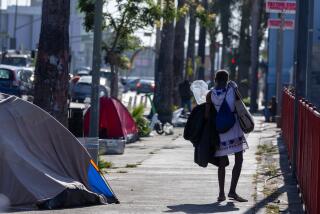County’s highest property taxes are in its poorest cities
Struggling to balance their budgets with meager tax bases, some of Los Angeles County’s poorest cities charge their residents the highest property tax rates.
Working-class cities such as Compton, San Fernando, Maywood, Huntington Park and Inglewood have among the highest property tax rates, while several upper-class cities on the Palos Verdes Peninsula and South Bay have among the lowest rates, records from the L.A. County auditor-controller show.
The Times reported last week that while Bell was paying its city manager nearly $800,000, it was also charging its residents the second highest tax rate in the county, surpassed only by a few residential parcels in the City of Industry.
But even without the burden of unusually large salaries, many small cities with low-income populations have pushed property tax rates much higher than their more affluent counterparts. The gap underscores the financial bind that cities face and the regressive nature of property taxes, fiscal experts said.
Cities in affluent areas can keep rates relatively low because the higher value of homes brings in sufficient revenue, said John M. Quigley, an economics and public policy professor at UC Berkeley. For example, a home assessed at $1 million and taxed at 1% would generate $10,000 in annual revenue while a property assessed at $220,000 taxed at 1.25% raises $2,750.
“Property taxes are often inversely related to the wealth of the city,” Quigley said.
Take the case of Redondo Beach, which has a median household income of $92,263. The city’s property tax rate is one of the lowest — 1.074%, and city officials don’t see a need to raise it because property in the beach town is so pricey.
“As a beach community, we tend to have higher housing values,” Assistant City Manager David Biggs said.
An additional problem facing low-income cities, particularly during the current economic downturn, is that many have scanty commercial districts that generate little sales taxrevenue. As a result, poorer cities tend to be more dependent on property tax revenue than wealthier ones.
Of the 10 Los Angeles County cities with the highest property tax rates, six had median household incomes below $50,000. Among the 10 cities with the lowest rates, seven had median incomes above $100,000 and six had median incomes above $128,000.
Redondo Beach, Manhattan Beach, Palos Verdes Estates, Rancho Palos Verdes, Rolling Hills, Rolling Hills Estates, Cerritos and La Habra Heights had some of the lowest property tax rates, the data show. Hidden Hills — with a median income of $203,000 — ranked 69th while Beverly Hills ranked 63rd. The city of Los Angeles ranked 13th, with a property tax rate of 1.22%.
There were exceptions to the pattern. Bellflower, a city with a median household income of $53,000, recorded the lowest tax rate in the county: 1.02%.
All county property owners pay a 1% general property tax, along with special or direct assessments levied by their municipalities. The countywide average of all tax rates is 1.16%, or $11.60 for every $1,000 of assessed value. That does not account for direct assessments for services charged by cities, including lighting, sewage, refuse and others.
Bell and other cities with high rates have so-called special taxes that were added to property tax bills before Proposition 13 required two-thirds voter approval to do so. Bell and San Fernando have pension taxes to pay for the retirements of city workers.
Robert Ordelheide, who is retiring as San Fernando’s interim city administrator, said the city wouldn’t be able to pay retiree benefits without the higher property tax rate of 1.46%, the fourth highest in the county.
Voters in working-class communities seem to be more willing than wealthier voters to support tax increases that are described as being beneficial to their cities, said Bill Fulton, a planning expert and author of “The Reluctant Metropolis,” which looked in part at struggling communities in southeast Los Angeles.
“There is a definitive desire for upward mobility. So libraries, schools, roads, all of those will pop with working-class voters,” Fulton said. “It’s related to the aspirations of the working-class Latino in L.A.”
By contrast, La Habra Heights, which has the second lowest property tax rate, “is a conservative city,” said Shauna Clark, the city manager. “They rely on having built up very large reserves and on staying out of debt.”
In predominantly immigrant cities like Bell, it’s also possible that some residents are not fully aware of the taxes the city is levying. At recent public meetings, some Bell residents said the city government never explained where their property taxes were going. In one special election in 2005, only about 500 people voted. In a 2003 election, a $70-million bond measure passed with just over 700 votes. Bell has more than 9,000 registered voters.
catherine.saillant@latimes.com
sam.allen@latimes.com
More to Read
Sign up for Essential California
The most important California stories and recommendations in your inbox every morning.
You may occasionally receive promotional content from the Los Angeles Times.











